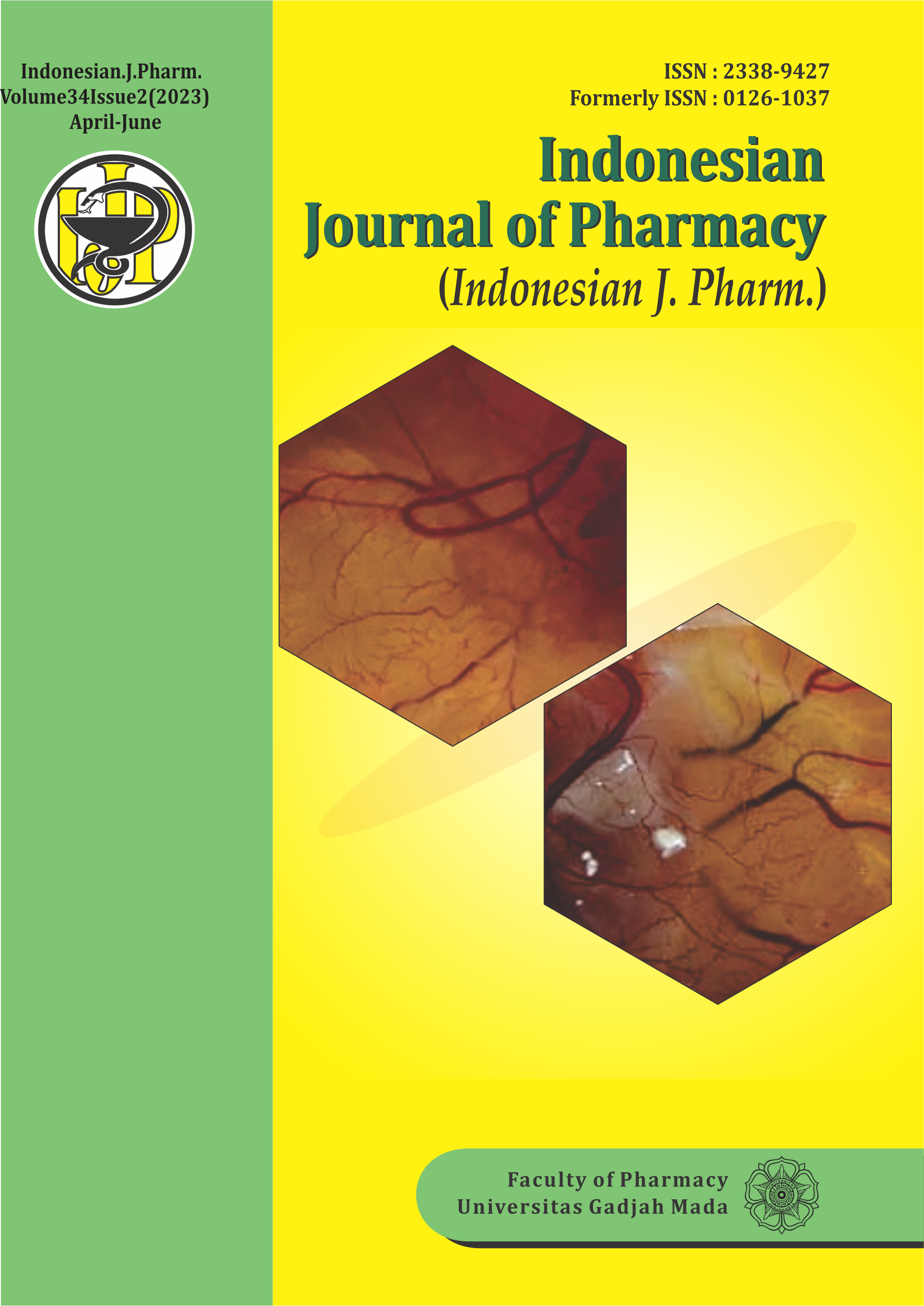Bioactivity Profiles of Actinobacterium Strain BTA 1-131 (InaCC A1205) Isolated from Indonesian Sponge Melophlus sarassinorum
Abstract
The phylum Actinobacteria recognized as the most promising producers of many bioactive compounds. Among actinobacteria, the genus Streptomyces are widely known as prolific producers of many antibiotics, for example Streptomycin. The present study investigates potential bioactivity of actinobacteria BTA 1-131 isolated from an Indonesian marine sponge Melophlus sarassinorum. Molecular identification using the 16S rRNA gene sequencing showed that the isolate is similar to Streptomyces kunmingensis (98.4%). The isolate was cultivated on to three different fermentation media (ISP2, YS, and SYP) to select the best media for bioactive compounds production. The compounds were extracted from both solid and liquid cultures using methanol as a solvent. The crude methanol extracts were tested for antibacterial and anticancer activity. The bioactivity screening indicates active potential of the extracts against bacterial pathogen Staphylococcus aureus ATCC 13420, invasive breast cancer MDA-MB-231 and human colorectal adenocarcinoma cells CaCo-2. The extracts profiling using LC-MS/MS method indicates probable influence among different fermentation media to selectively induce production of target bioactive compounds. Although further compounds dereplication and fractionation are important for specific identification, the present study demonstrates the potential of Streptomyces BTA 1-131 as producer of tetracycline and/or staurosporine. In addition to that, further genome-mining approach and analysis using a whole genome sequencing data also important to comprehensively explore the bioactive potential of the actinobacteria BTA 1-131.
References
Antonious GF (2009). "Mobility and half-life of bensulide in agricultural soil". Journal of Environmental Science and Health, Part B. 45: 1. doi:10.1080/03601230903404283.
Arai M, Yamano Y, Kamiya K, Setiawan A & Kobayashi M. 2016. Anti-dormant mycobacterial activity and target molecule of melophlins, tetramic acid derivatives isolated from a marine sponge of Melophlus sp. J Nat Med 70: 467-475.
Brinkmann CM, Marker A & Kurtböke DI. 2017. An Overview on Marine Sponge-Symbiotic Bacteria as Unexhausted Sources for Natural Product Discovery. Diversity 9: 40.
Blunt, J. W., B. R. Copp, R. A. Keyzers, M. H. G. Munro and M. R. Prinsep 2017. "Marine natural products." Nat Prod Rep 34(3): 235-294
Carr, G.; Williams, D. E.; Díaz-Marrero Ana R.; Patrick, B. O.; Bottriell, H.; Balgi, A. D.; Donohue, E.; Roberge, M.; Andersen, R. J. 2010. Bafilomycins Produced in Culture by Streptomyces spp. Isolated from Marine Habitats Are Potent Inhibitors of Autophagy† J Nat Prod. 73 (3), 422-427
Cita, Y.P., Radjasa O.K., and Sudharmono, P. 2017. Aktivitas Antibakteri Isolat bakteri X2 yang Berasosiasi Spons Xestospongia testudinaria dari Pantai Pasir Putih Situbondo terhadap Bakteri Pseudomonas aeruginosa. Jurnal Ilmu Kefarmasian Indonesia. 14 (2), 206-211
Chopra I and Roberts MC. 2001. Tetracycline antibiotics: mode of action, applications, molecular biology, and epidemiology of bacterial resistance, Microbiol Mol Biol Rev 65: 232-60
Dita, S.M., Budiarti, S., and Lestari, Y. 2017. Sponge-Associated Actinobacteria: Morphological Character and Antibacterial Activity against Pathogenic Bacteria. Journal Sumberdaya Hayati 3, 21-26
Furusato, A., Kato, H., Nehira, T., Eguchi, K., Kawabata, T., Fujiwara, Y., Losung, F., Mangindaan, R.E., De Voogd, N.J., Takeya, M., Yokosawa, H., and Tsukamoto, S. 2014. Acanthomanzamines A-E with new manzamine frameworks from the marine sponge Acanthostrongylophora ingens. Org Lett 16, 3888-3891
Huffard, C.L., Erdmann, M.V., and Gunawan, T.R.P. 2012. "Geographic Priorities for Marine Biodiversity Conservation in Indonesia", (ed.) Program. (Jakarta).
Izzati, F., Warsito, M.F., Bayu, A., Prasetyoputri, A., Atikana, A., Sukmarini, L., Rahmawati, S.I., and Putra, M.Y. 2021. Chemical Diversity and Biological Activity of Secondary Metabolites Isolated from Indonesian Marine Invertebrates. Molecules 26
Kasmiati, K., Yoshioka, Y., Okamoto, T., and Ojika, M. 2018. New Crambescidin-Type Alkaloids from the Indonesian Marine Sponge Clathria bulbotoxa. Mar Drugs 16.
Kim NH, Lee SM, Kim YN, Jeon YJ, Heo JD, Jeong EJ, & Rho JR. 2020. Standardized Fraction of Turbinaria ornata Alleviates Dextran Sulfate Sodium-Induced Chronic Colitis in C57BL/6 Mice via Upregulation of FOXP3+ Regulatory T Cells. Biomolecule 10(10):1463. https://doi.org/10.3390/biom10101463
Leal MC, Rocha RJM, Rosa R, & Calado R. 2018. Aquaculture of marine non-food organisms: what, why and how? Rev Aquac 10, 400-423.
Maslin M, Gertner-Mazouni N, Debitus C, Joy N, & Ho R, 2021. Marine sponge aquaculture towards drug development: An ongoing history of technical, ecological, chemical considerations and challenges. Aquaculture reports 21. https://doi.org/10.1016/j.aqrep.2021.100813.
Murniasih T., Indriany E.A., Putra M.Y., and Untari, F., 2016. The antibacterial capacity of marine bacteria isolated from sponge Acanthella cavernosa collected from Lombok Island. Journal of Coastal Life Medicine 4 (10), 775-778.
Murniasih T., Cindhy C.I., Putra M.Y. and Sukara E., 2020. Anti-mycobacterium compound derived from Erythrobacter sp. isolated from Callyspongia aurizusa IOP Conf. Series: Earth and Environmental Science 429 (1), 012009.
NCATS, 2022. NCATS Inxight Drugs—GENTIOBIOSE. Retrieved December 5, 2022, from https://drugs.ncats.io/drug/HF30HB040V.
Putra, S.A. 2020. Rapid surveys reveal healthy coral-sponge communities on Krakatau reefs. Berita Biologi 19.
Prastya M.E., Astuti R.I, Batubara I., and Wahyudi A.T., 2019. Antioxidant, antiglycation and in vivo antiaging effects of metabolite extracts from marine sponge-associated bacteria. Indian Journal of Pharmaceutical Sciences 81 (2), 344-353.
Pinedo-Rivilla C, Aleu J, Durán-Patrón R. 2022. Cryptic Metabolites from Marine-Derived Microorganisms Using OSMAC and Epigenetic Approaches. Mar Drugs. 20(2):84. doi: 10.3390/md20020084.
Raharja N.I., Widanarni W., and Wahyudi A.T., 2019. Marine sponge-associated bacteria as biocontrol agents of vibriosis on whiteleg shrimp caused by Vibrio parahaemolyticus. Biodiversitas 20 (11), 3164-3169
Romano S, Jackson SA, Patry S, Dobson ADW. 2018. Extending the "One Strain Many Compounds" (OSMAC) Principle to Marine Microorganisms. Mar Drugs. 23;16(7):244. doi: 10.3390/md16070244
Santhi LS, Vssl PT, Sy N, & Krishna ER. 2017. Bioactive Compounds from Marine Sponge Associates: Antibiotics from Bacillus Sp. Natural Products Chemistry & Research 05.
Santos-Gandelman J, Giambiagi-Demarval M, Oelemann W, & Laport M. 2014. Biotechnological Potential of Sponge-Associated Bacteria. Current Pharmaceutical Biotechnology 15, 143-155.
Sadahiro Y., Hitora Y., Fukumoto A., Ise Y, Angkouw E.D., Mangindaan R.E.P, and Tsukamoto S., 2020. Melophluosides A and B, new triterpene galactosides from the marine sponge Melophlus sarasinorum, Tetrahedron Letters 61(20), 151852, https://doi.org/10.1016/j.tetlet.2020.151852.
Sugisawa, H. and Hiroshi E. 1966. "The Thermal Degradation of Sugars I. Thermal Polymerization of Glucose". Journal of Food Science. 31 (4): 561. doi:10.1111/j.1365-2621.1966.tb01905.x.
Subramani R. & Sipkema D. 2019. Marine Rare Actinomycetes: A Promising Source of Structurally Diverse and Unique Novel Natural Products. Mar Drugs 17.
Subramani R & Aalbersberg W. 2012. Marine Actinomycetes: An Ongoing Source of Novel Bioactive Metabolites. Microbiol Res 167, 571-580.
Wang F., Chen Y., Hermens J.L.M, Droge S.T.J. 2013. Evaluation of passive samplers with neutral or ion-exchange polymer coatings to determine freely dissolved concentrations of the basic surfactant lauryl diethanolamine: Measurements of acid dissociation constant and organic carbon–water sorption coefficient. Journal of Chromatography A 1315, 8-14, https://doi.org/10.1016/j.chroma.2013.09.041.
Wang CY, Wang BG, Wiryowidagdo S, Wray V, van Soest R, Steube KG, Guan HS, Proksch P & Ebel R. 2003. Melophlins C-O, Thirteen Novel Tetramic Acids from the Marine Sponge Melophlus sarassinorum. J Nat Prod 66: 51-56.
Waters A.L, Peraud O., Kasanah N., Sims J.W., Kothalawala N., Anderson M.A., Abbas S.H., Rao K.V., Jupally V.R., Kelly M., Dass A., Hill R.T., and Hamann M.T., 2014. An analysis of the sponge Acanthostrongylophora igens' microbiome yields an actinomycete that produces the natural product manzamine A. Frontiers in Marine Science 1 (54), 1-15.
Wei, HX., Fang, XW., Xie, XS., Zhang, S.P., Jiang, Y., and Wu, S.H. 2017. Secondary Metabolites of a Soil-Derived Streptomyces kunmingensis . Chem Nat Compd 53, 794–796. https://doi.org/10.1007/s10600-017-2125-x








